 Back to selection
Back to selection
How Alex Ross Perry and DP Robert Kolodny Made a New Video for Pavement’s “Harness Your Hopes”
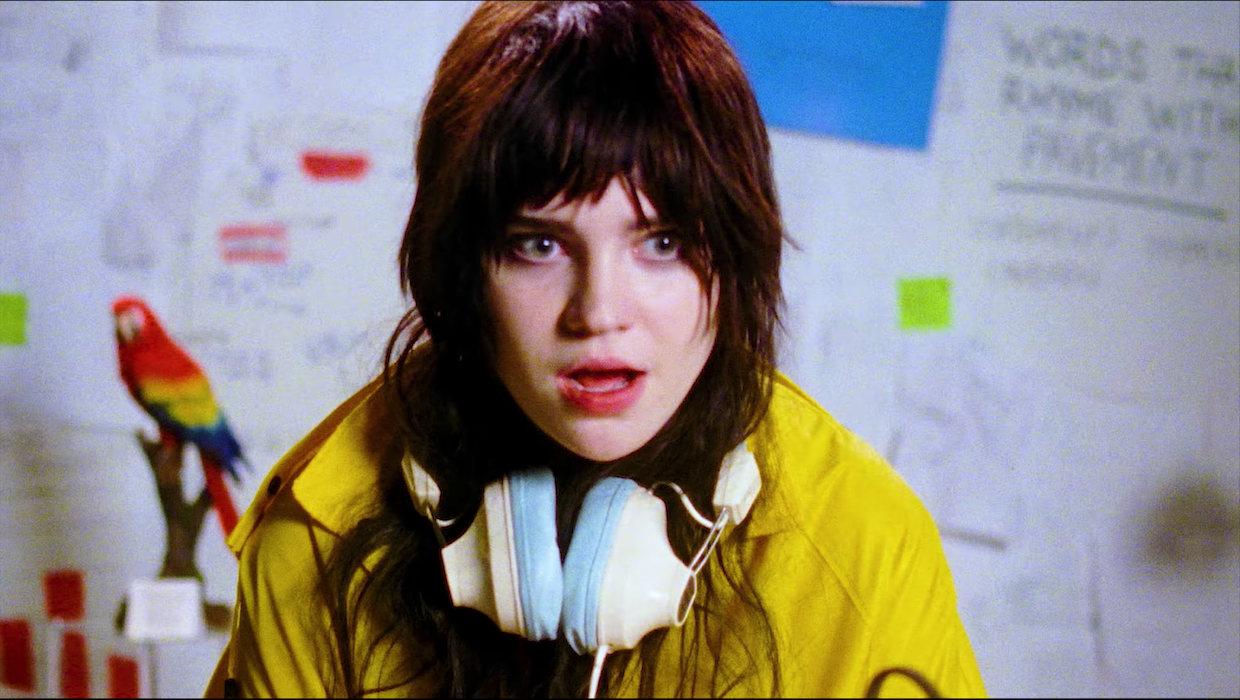 Sophie Thatcher in Pavement's "Harness Your Hopes” music video
Sophie Thatcher in Pavement's "Harness Your Hopes” music video In 2017, the formerly obscure Pavement B-side “Harness Your Hopes” became their number one track on Spotify. It currently has 70 million plays, over twice the amount of “Cut Your Hair,” the group’s highest charting and arguably most popular song during their original run. At Stereogum, Nate Rogers looked into why exactly “Harness Your Hopes” became as prevalent as it had and all signs point to Spotify’s Autoplay feature, which “cues up music that ‘resembles’ what you’ve just been listening to, based on a series of sonic signifiers too complex to describe.” At this point, “Harness Your Hopes” has crossed over into something of a bona fide hit across multiple platforms, including TikTok, where users have been making up their own dances to the song. (The first comment under the linked YouTube compilation reads, “THATS IT IM GONNA START GATEKEEPING”.)
It makes sense that Pavement and their label, Matador Records, would want to recognize this strange, unforeseen achievement in some way. A month ago, the band premiered a “Harness Your Hopes” music video ahead of both Terror Twilight: Farewell Horizontal—a deluxe reissue box set of Pavement’s fifth and final album, the long-awaited final compilation in a series dating back to 2002—and a reissue of the Spit on a Stranger EP, on which “Harness Your Hopes” originally appears. (Both are available to stream and purchase now.) Directed by Alex Ross Perry, the video stars actress Sophie Thatcher, of Yellowjackets fame, as an obsessive Pavement fan who’s transported into all of the band’s ’90s music videos. The videos themselves appear via rear projection crafted by the director and cinematographer Rob Kolodny, the credited editor, colorist and archivist. (The video’s DP is Hil Steadman.)
A cheeky homage to Pavement’s history that feels neither fulsome nor too obvious, it also functions as a touching effort to reenergize the band’s music for a younger generation, validating their look and sound by collapsing the past and present through Thatcher’s fan’s eyes. I spoke with Perry and Kolodny about the challenges and joys of putting together this video.
Filmmaker: I’m curious if you can remember when you first heard Pavement?
Perry: That would be very difficult to answer, because they were fairly ubiquitous on alternative rock radio at a time that I listened to it a lot. When I re-heard “Stereo” years later, after many years unplugged from things that played music that I wasn’t selecting, I was like, “Oh my God, this was everywhere for a while.”
Filmmaker: How did the concept of the “Harness Your Hopes” video come about?
Perry: [Matador] said, “We want you to do this. Will you do this? Obviously the band has to be in it, and obviously the band can’t be in it. So, come up with some concepts and a treatment or two. Solve that problem in a way that is organic and correct to the tone, mood and spirit of Pavement.” That’s to say, this cannot be a hagiographic, tender depiction of the band, because that’s not in fitting with the way they represented themselves in interviews and their videos. An initial idea that maybe was one step closer to iconography was deemed a “little too on the nose,” then I thought, “Well, the solution to this is clear to me now”—it’s to reference the Peter Hyams movie Stay Tuned. Do that movie, but with Pavement in four minutes. Play with all of this old existing ’90s ephemera and see how far we can go with that, both technically and narratively. Immediately people were like, “That’s playful, that’s visual, it’s kind of a dumb idea. Therefore, it’s perfect for this band, for the history of their videos.”
Filmmaker: I remember watching and enjoying Stay Tuned as a child but haven’t even thought about that movie in like 20 years.
Perry: It’s a movie I really love and watched a lot, because it was similar to the goals of this video, [which] allowed me to synthesize a lot of different aesthetic concepts of television. When I got a DVD of it years later and re-watched it, I was like, “This meant nothing to me at the time, but I thought it was funny. Now I actually get this reference and it’s actually quite smart.” [So, the idea was,] we’ll take Sophie [Thatcher] and put her within, in front of or next to all of these [shots]. Some of these things are gonna go by so fast, and because of the nature of how we’re extracting the original shots, you can only use certain kinds of shots. Static shots, moving shots—you have to be very, very surgical in the shots you use from the old videos. So, we knew that some of these moments would be two or three seconds long, but we still had to commit to it so that we can get everything in there.
Filmmaker: How did you decide that rear projections were crucial to paying tribute to the band’s video history?
Perry: Once I said to Matador, “We’ll put her into all of the old videos,” people said, “Great, very good idea.” Then I said, “Technically, literally, I don’t know how to do this.” Obviously, you can green screen, that’s one way to do it. [But] if you do green screen, the job is not over when you leave the set.
Kolodny: [When] Alex reached out to me about the video, [he pitched] it as light on post-production after the shoot, but before the shoot there was quite a bit of post-production to be done—which is antithetical to what the post process is, but alright, let’s hear ya out. So, we laid out this idea that I think [gaffer and electrician] Danny April helped him formulate, that we should do rear projection rather than green screen.
Perry: Once we knew that the shots we’d be putting her into were rarely longer than five seconds long, we thought it would be a lot more organic, and therefore more ’90s and simpler, to just play rear projection.
Kolodny: Matador opened their archives to me and I was able to take the source videos of all the previous music videos, as well as live performances, and play around with them. In some cases, I took frames that we could insert an actor into and either elongated or looped them, or added forward and reverse motion to them. In others, I did a lot of compositing work where I would rotoscope out the members of the band for static shots. “Cut Your Hair,” for example: I would take the band out and have it exist as a space that we could have Sophie walk through and interact with, then—on the production design side—add an actual barber stool or chair.
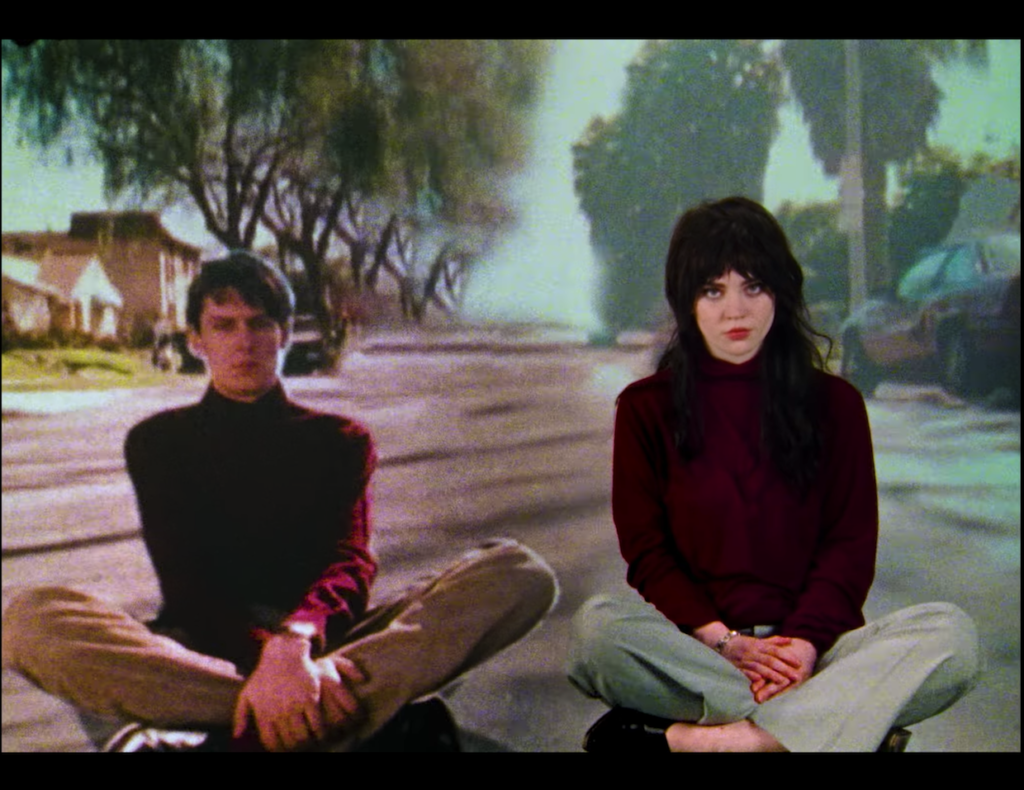
In other instances, you know, [in the “Shady Lane” video] there’s this iconic shot of Stephen Malkmus sitting on the asphalt. A car is coming up and about to hit him, then he has no head for the rest of the video. In my mind, I thought it would be great to have either a version of that street totally clean, in which case I had to rotoscope Malkmus out, or a version where Malkmus was much smaller and we positioned Sophie beside him. We did both options, and it took a fair amount of rotoscoping and clone stamping and, on top of that, creating texture that allows it all to feel as one thing.
An additional technical issue that’s probably worth talking about is that all of these videos are standard definition videos. Even on the archival end, some of them were as low as 480p.
Perry: Of the 12 or so videos, I don’t think more than three or four of them have the same quality level. So, putting the original images a little further away was necessary, because if we were trying to greenscreen her into them, some look really good and some look less good. It would have been harder to keep track of that than just saying, “The image that we’re concerned about is shooting the actors on the sound stage. The wallpaper is this old video playing behind her, but it will go by quickly enough and [the new footage was] shot on film, so it will have its own aesthetic. What you have back there matters ever so slightly less than if we were putting the original images front and center.”
Kolodny: Blowing it up for rear projection, the bigger we go, the more loss we’re gonna have in image quality. What is the midpoint between digital artefacting and what eventually will resolve as 16mm grain for what we’re shooting on? I had to do some tests. I have a projector in my apartment, so I would export videos and eye them. Does this need more digital distortion? Do I want to interlace the whole thing and have it play as that kind of antiquated aesthetic? There were some instances where I added some degree of the 16mm grain into what would become the rear projection, knowing that it would play as a little bit grainier, and therefore, perhaps, as some level of depth on top of what was given already.
Perry: The [problem with] doing the special effect-y green-screen version of having her interact with them in the video is that you don’t have the opportunity to create new shots. The stuff we did with [Sophie] in the Santa suit for the “Gold Soundz” video is a bit of both: some shots are her running with them, and some shots are her catching the chicken that they’re throwing— if we were just putting her, in we couldn’t have her interact with anything necessarily. But by putting her in front, we could just do close-ups with the vague shape of the original video behind her. It’s kind of hard to explain, because it’s both incredibly complicated and incredibly simple—which is to say, basically what Pavement’s music is.
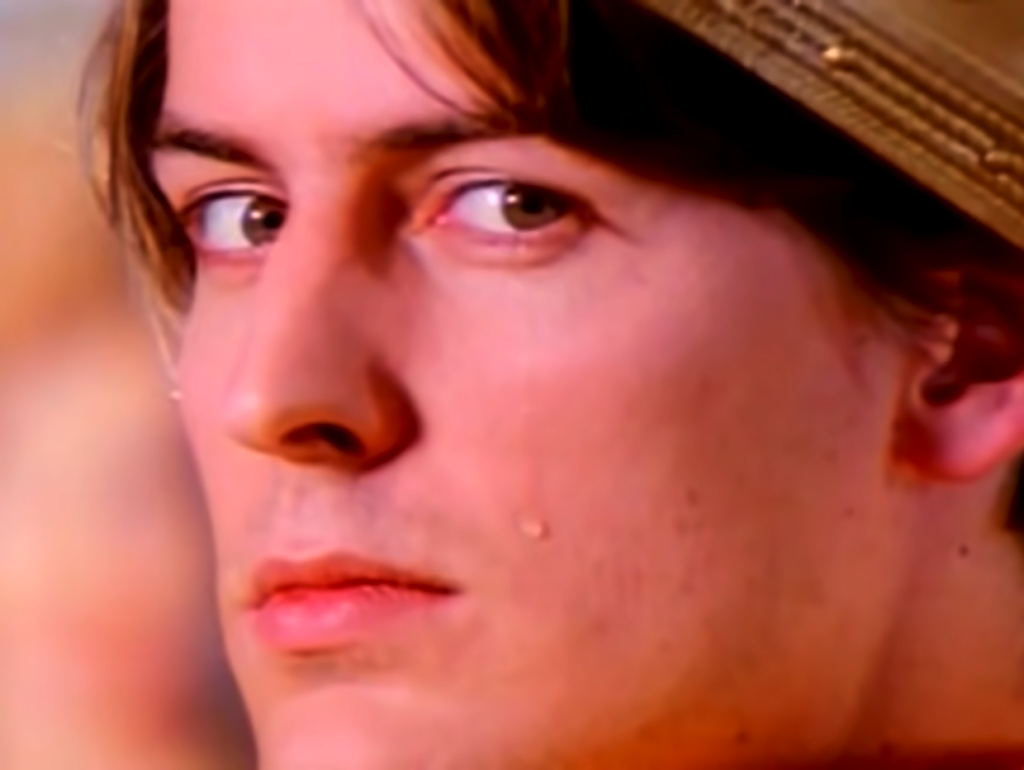
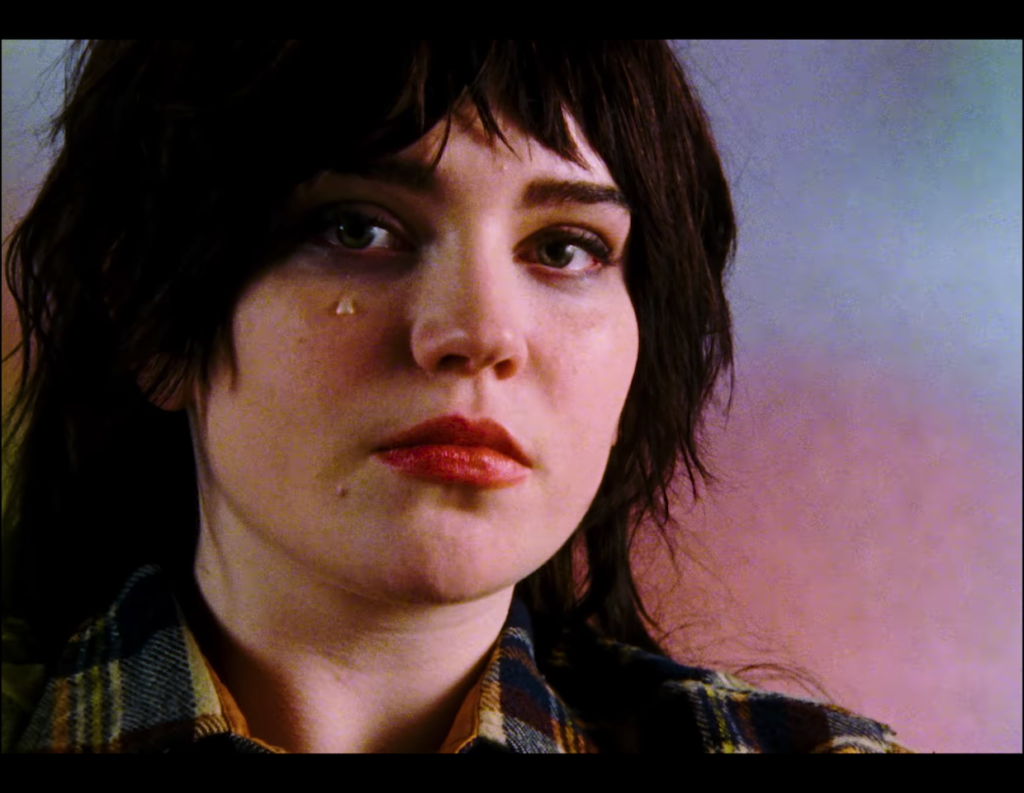
Kolodny: In the “Cut My Hair” video, there’s this shot of Malkmus wearing a crown, turning towards camera, a single tear drop rolling down his cheek. It’s the only shot in the video where it feels like they shot on a longer lens. We wanted it to match a shot of Sophie weeping in the same way. So, I found the wide reverse where the band is all sitting down and estimated—it looked like they were shooting on something like a 75-to-85mm lens. I blew up that background, isolated the motion, then added a defocused blur that I felt represented that same kind of focal length. We shot Sophie in focus with that as the rear projection, but still had her positioned close enough to the rear projection where she’s in exposure with the lighting, knowing it would play as a real match shot of Malkmus. I think it worked quite well.
Filmmaker: I don’t really know Sophie’s work that well. Was she a fan of the band before the video?
Perry: A huge fan. I know this from talking to her and from things she posts on Instagram, where she is very open about the music she’s listening to. Silver Jews are, I think, very spiritually important to her, and I think her affinity for Pavement bleeds out of her very emotional relationship with David Berman and his music. Therefore, she clearly has a fondness for all things adjacent to that. So, when the idea came up of, “We need a young fan,” she was the first and only person I thought of. I only mention that to say, I’m not telling personal anecdotes about music she tells me she likes. If you follow her [on Instagram], it will be very apparent what music she’s listening to and when. But it was fun to say, “Is it possible to cast somebody in this who was not born when Pavement last put out an album and broke up and this song was released? Someone whose life comes after 1999?”
Filmmaker: How long was the shoot?
Perry: One incredibly excruciating and tediously challenging day. It should have been two [days] and could have been three. Typically music videos nowadays—this is tied for the biggest budget I’ve ever had for a music video—it’s not a lot. They tend to have to be one day by default, because when you’re talking about day rates for a crew, one day is one day and two days is double. So, you really have to be very diligent. It was one day, but with a lot of planning. There was a day beforehand of soundstage work, building the lab set, testing the rear projection. Rob had been extracting the clips and doing his manipulation and trickery all week, so that was ready to go.
Kolodny: For every clip you see, there were probably five to eight slight variations. On set, the studio had two separate rooms. One was the room the production designer built out, the laboratory area and the bathtub, and the other was a white sight studio where our friends at Rooftop Films set up the projector screen that we would use for the rear projection. I was in that rear projection room for most of the day, live cuing all of the rear projection elements, and we would go through, throwing things at the wall and seeing what stuck. It was as smooth as it could have gone, I suppose.
Perry: Even if there’s no sound, no dialogue, you’re not moving locations, just putting somebody in 14 different outfits and having 14 different slightly adjusted lighting schemes to match slightly different source material—there’s just no way around it, that’s going to take a long time. It’s not fast and easy to say, “This ‘Stereo’” video is filmed inside a white soundstage, so we have to match that lighting, which is easy, then this ‘Gold Soundz’ video is filmed outside in California, so we have to match that lighting, which is less easy.” Those things all take time and we were doing over a dozen of them. The filming of each one was ten minutes, then there would be 45 minutes until we were doing the next one.
This had a fairly sizable crew with a lot of resources. [This video had] a larger budget than the first two movies I made. Having come from making a 16mm indie feature for $20,000, having made that amount of money last for a three-week shoot, it’s really fun for me to spend roughly that amount in one day on a fairly complex and well-staffed music video. It’s not a lot of money and only gets you so far, but it’s perversely exciting.
Filmmaker: What was the other most expensive video?
Perry: The first video I did for Sleigh Bells. Weirdly, it also had rear projection, which makes it sound like that’s the isolate-the-variable element that makes things cost a lot of money. It’s really not; it’s just a coincidence that those are the only times that I ever reached a certain budget level on these things.
Filmmaker: I think what’s really effective about the video is that the interpolation of present-day footage with the old videos feels both seamless and not. By interpolating Sophie and the band’s music video history, you’re having two generations engage in conversation with one another. I’m not sure what to attribute that to visually—the use of 16mm, the editing, color grading, etc.
Kolodny: A universal fact that is true of all Pavement videos, ours included, is that there is a general kind of nonchalant malaise that totally coats everything. Look at any of the videos. It’s like, “Well, this could look much better somehow. It just looks like they didn’t care”—which I think is the quintessential kind of Pavement attitude. To make a video that would be overproduced or too glossy, having a sheen that is either too modern or too drenched in the idea of nostalgia, would be disingenuous to the band. To that end, as I was editing, I was cutting in a mode antithetical to a music video that I would edit for a current artist or track. [The process] had kind of this philosophy of how Pavement videos look, while being cognizant not to fetishize the retro factor of it.
The color correction, which I did myself as well, was a long-form process that we went through a lot of notes with, but there was a sense of trying to get the colors to feel in this midground between what ’90s progressive scan videos look like vs. what our 16mm stuff looks like. That wraps in the technical reality of rear projection, always getting a lot of light from the back of your source. There’s a lot of light bouncing around the room. So, dealing with how that halation plays with the camera, the lens, the barrel and taking that down; adding contrast, saturation, in some cases more grain.
Filmmaker: Were you getting most of the notes from Matador?
Kolodny: The first round was Matador, who had very few notes but they were good. There is a shot of Malkmus at a golf course [from the “Major League” video], and we have Sophie next to him. In a lot of the shots, Malkmus is singing the original song that video is for, and one of Matador’s notes was, it doesn’t quite make sense that you’ve put all of this work into [ensuring] when you see Malkmus sing it looks like he’s singing “Harness Your Hopes,” except for in this video [where] he’s clearly singing some other song. There was a moment of crisis in my mind, where I was like, “Oh man, these are the only shots we have for this video. How can we supplement it?” I wound up taking the video, isolating the motion of Malkmus’s head in between shots when he’s singing, moments where he’s just standing or between words, then cloning that into a loop, putting that over his actual head and feathering it out, so it appears that he’s just standing and bobbing his head to the beat.
The feedback from the band was generally, “Yeah, we’re into this.” It was both amazing to have any interaction with a band like Pavement commenting on work that I’ve done, and equally satiating that it was as slacker in response as you would imagine. Just like, “Oh, OK. It’s good.” which is the best response I could possibly hope for.
Filmmaker: That’s the one you want.
Kolodny: Yeah, exactly. “It doesn’t suck.”

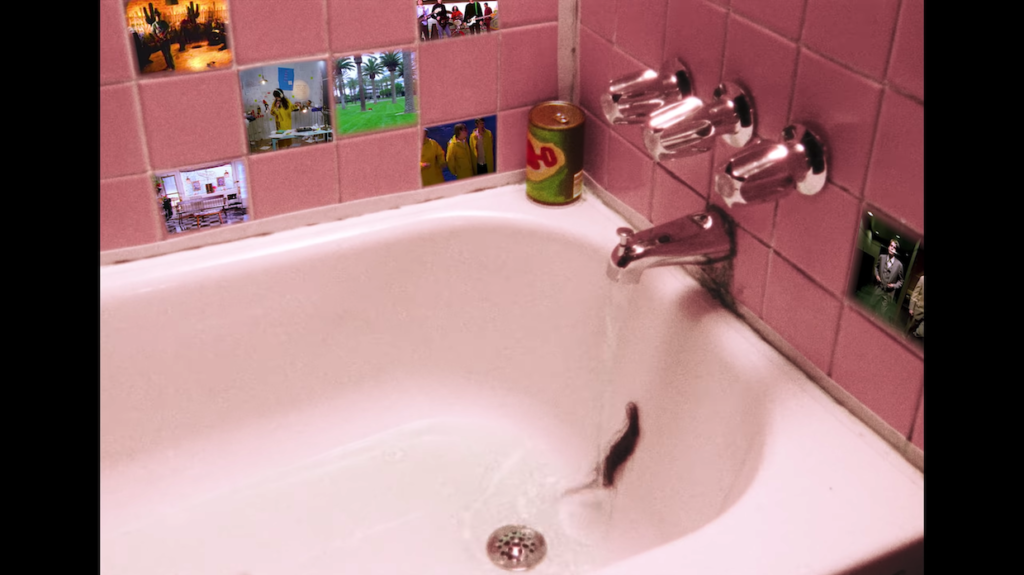
Filmmaker: Did any other specific shots from the videos give you trouble?
Kolodny: The bathtub shot [from “Rattled by the Rush”]. We went through great pains to make it as similar to the original as possible, and the original color temperature of it is totally wacky in the first place. So, it was a crazy process to reverse engineer something that was potentially not photographed in the best way initially. We had to do things like isolate the color of the water so it’s teal green. There’s a cylinder of soap in the corner, [we had to isolate that] so that it has the proper renditions of the reds and greens and silvers, and most importantly, have the tiles play as close to this muted pink tone as we could without having the whole image fall apart. And then having 12 layers of tiny videos on top of them.
Filmmaker: It’s so funny hearing you talk about this because it seems like the absolute opposite of the Beavis & Butthead line on Pavement: “They need to try harder.”
Kolodny: There was no shortage of me thinking about that exact same clip, imagining Beavis and Butthead commenting, and laughing at myself toiling in discontent as an hour-and-a-half render bar is crawling across my screen to get three seconds [of footage] to look like something that should feel totally off the cuff and nonchalant.
